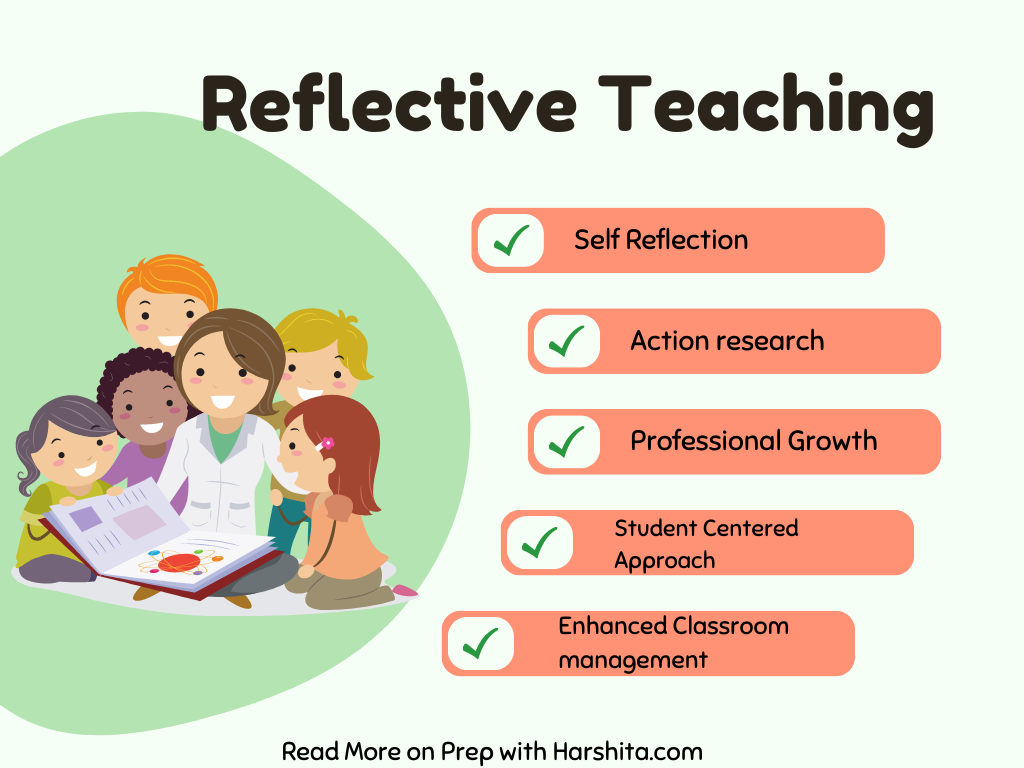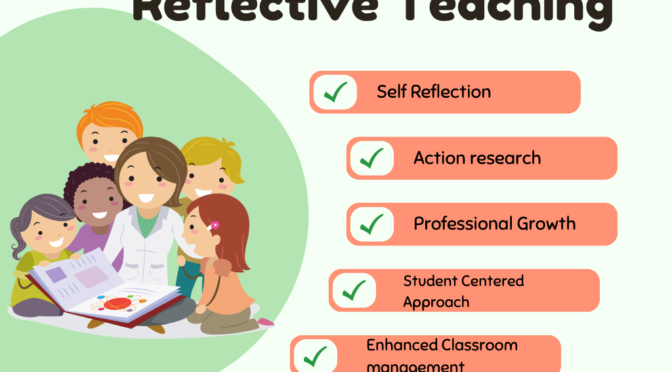Reflective teaching is an approach that involves self-examination, critical analysis, and thoughtful evaluation of one’s teaching practices and their impact on student learning. It encourages educators to engage in a continuous cycle of reflection, action, and improvement to enhance their teaching effectiveness.
Here are the key aspects and benefits of reflective teaching:
- Self-Reflection: Reflective teaching starts with introspection and self-reflection. Educators examine their beliefs, values, teaching strategies, and instructional decisions. They reflect on their goals, instructional practices, and classroom dynamics to gain insight into their strengths, areas for improvement, and the impact on student learning.
- Action Research: Reflective teaching often involves conducting action research to investigate specific aspects of teaching and learning. Educators collect data, analyze it, and make informed decisions based on the findings. Action research allows teachers to make evidence-based adjustments to their instructional strategies and interventions.
- Professional Growth: Reflective teaching supports continuous professional growth. By critically examining their teaching practices, educators identify areas where they can develop new skills, explore innovative approaches, and incorporate research-based strategies into their instruction. It encourages a commitment to lifelong learning and ongoing improvement.
- Student-Centered Approach: Reflective teaching places a strong emphasis on student learning and outcomes. Educators consider how their teaching practices impact student engagement, understanding, and achievement. They assess whether their instructional methods effectively address the diverse needs, learning styles, and abilities of their students.
- Improved Instructional Decision-Making: It helps teachers make informed instructional decisions. Through reflection, educators evaluate the effectiveness of their teaching strategies, learning materials, and assessments. They adjust their instruction based on the feedback received from students, assessment results, and ongoing observations to better meet student needs.
- Enhanced Classroom Management: It involves analyzing classroom management practices and strategies. Educators consider the impact of their behavior management techniques, rules, routines, and classroom environment on student behavior and engagement. They make necessary adjustments to promote a positive and inclusive learning environment.
- Collaboration and Peer Feedback: It encourages collaboration and the sharing of experiences with colleagues. Educators can engage in professional learning communities, peer observations, and collaborative discussions to gain different perspectives, exchange ideas, and receive constructive feedback. This collaboration supports professional growth and expands instructional knowledge and practices.
- Student Reflection: Reflective teaching also involves encouraging students to reflect on their own learning. Educators incorporate reflection activities and strategies that help students evaluate their progress, strengths, and areas for growth. Student reflection fosters metacognitive skills, self-assessment, and a sense of ownership over learning.
- Culturally Responsive Teaching: Reflective teaching prompts educators to examine their cultural assumptions, biases, and practices. They reflect on how their teaching respects and values the diverse cultural backgrounds, experiences, and identities of their students. By embracing culturally responsive teaching practices, educators create inclusive learning environments that affirm and engage all learners.
Reflective teaching is a continuous process that requires time for contemplation, self-assessment, and thoughtful planning. It encourages educators to embrace a growth mindset, engage in professional development, and seek feedback from students, colleagues, and administrators. By engaging in reflective teaching practices, educators can continually refine their instructional approaches, improve student outcomes, and create meaningful learning experiences for their students.
Also Read : Cooperative Learning

Also Visit : Prep with Harshita


It was amasing post. Lets try to plau unblocked games
equilibrado estatico
Dispositivos de equilibrado: importante para el funcionamiento uniforme y óptimo de las dispositivos.
En el campo de la tecnología actual, donde la efectividad y la estabilidad del dispositivo son de suma significancia, los equipos de balanceo juegan un papel fundamental. Estos equipos especializados están creados para ajustar y estabilizar partes giratorias, ya sea en maquinaria industrial, medios de transporte de movilidad o incluso en electrodomésticos caseros.
Para los técnicos en mantenimiento de equipos y los ingenieros, trabajar con sistemas de balanceo es crucial para proteger el funcionamiento suave y fiable de cualquier sistema rotativo. Gracias a estas alternativas innovadoras sofisticadas, es posible reducir sustancialmente las movimientos, el estruendo y la tensión sobre los soportes, extendiendo la tiempo de servicio de piezas importantes.
También significativo es el papel que desempeñan los equipos de balanceo en la servicio al consumidor. El soporte especializado y el conservación regular utilizando estos equipos posibilitan ofrecer servicios de gran estándar, elevando la bienestar de los consumidores.
Para los responsables de emprendimientos, la financiamiento en equipos de calibración y dispositivos puede ser fundamental para aumentar la rendimiento y eficiencia de sus aparatos. Esto es principalmente relevante para los inversores que manejan modestas y pequeñas empresas, donde cada punto es relevante.
También, los sistemas de equilibrado tienen una extensa aplicación en el sector de la seguridad y el monitoreo de nivel. Permiten localizar probables errores, evitando mantenimientos elevadas y problemas a los sistemas. También, los indicadores recopilados de estos sistemas pueden aplicarse para maximizar procesos y incrementar la exposición en sistemas de consulta.
Las zonas de aplicación de los dispositivos de equilibrado comprenden diversas sectores, desde la elaboración de ciclos hasta el seguimiento de la naturaleza. No interesa si se habla de importantes elaboraciones productivas o pequeños locales caseros, los sistemas de equilibrado son esenciales para proteger un funcionamiento productivo y sin detenciones.